Moon Water - Our Ticket to the Solar System!
Dr Jamie Love 12 March 1998 ©
12 March 1998 ©
 12 March 1998 ©
12 March 1998 ©
I was a teenager during the Apollo years and I watched with excitement
as the astronauts bounce around our first "alien world".
The Apollo program ended prematurely nearly three decades ago
and analysis of the rocks returned showed
that the Moon was rich in minerals and metals, but it had no water.
Although this was a disappointment it came as no surprise. Scientists
had long speculated that the Moon would be dry.
This was based
upon our understanding of how water should behave on the surface
of the Moon.
Sunlight falling on molecules of water will heat them, causing them to wiggle violently and move rapidly. This is caused by the transfer of energy (sunlight) to the water molecules. It happens on Earth too, but on the Moon it happens to a much greater degree for three reasons.
 |
First, there is no atmosphere on the Moon,
so there is nothing to shield the water from the sun's powerful
rays.
Second, the lack of an atmosphere on the Moon means that water molecules will not be slowed down by bumping into other molecules so they are able to maintain their speed. Third, the Moon takes four weeks to rotate around its axis so its "daytime" lasts 14 (Earth) days, so there's plenty of time for the water on the Moon to be heated by the sun. |
Water molecules on the Moons' surface exposed to the rays of the sun for days on end will pick up so much energy and move so quickly that they will reach "escape velocity". Escape velocity is the velocity (speed) needed to escape the gravitational pull of a planet or moon.
|
No, that's not completely true. You never truly "escape"
a planet's gravitational pull. Gravity extends throughout the
universe, but its force drops quickly with distance so it's easy
to think that after a certain distance you have "escaped"
from it. When something reaches and maintains escape velocity
the gravity from the planet (or moon) can no longer pull it back;
although it is still pulling, at least a little. Because of this
little bit of constant pulling, some physicists might argue that
there is no such thing as "escape velocity", because
you never completely escape the gravity of a planet. However,
engineers who work with more practical definitions,
explain that this little bit of tugging can be ignored, in most
cases, so escape velocity is a real and useful value.
If a molecule of water, or a rocketship, can achieve escape velocity and maintain it for long enough, it will "escape" from the planet or moon. Escape velocity is important to astronomers seeking molecules on other worlds and it's important to engineers designing rockets to get there! The Moon has much less gravity than the Earth, about 1/6th, because it is much smaller than Earth, so the Moon's escape velocity is much lower than the Earth's escape velocity. That means it takes less energy to launch water molecules or rockets from the Moon than from the Earth. | 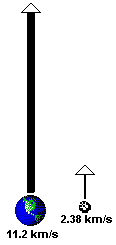 |
Another important difference between launches from the Earth or the Moon is that the Earth's atmosphere gets in the way. Atmosphere causes drag and drag slows things down. The drag caused by the Earth's atmosphere works against a rocket or a water molecule. That means it's harder to MAINTAIN escape velocity through the Earth's atmosphere. Atmospheric drag is a big problem for rocket engineers.
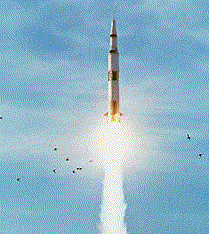 |
Rockets launched from the Earth are designed with smooth,
streamline shapes in order to help push the atmosphere aside and
let the rocket get through with as little drag as possible.
Rockets launched from the Moon do not have to fight through an atmosphere. They experience no drag, so they can be any shape. The rocket that launched men from the Earth to the Moon (a Saturn V like the one on the left) was streamline. The rocket that launched men from the Moon to the Earth (the Lunar Excursion Module, or LEM, on the right) looked like it was built to stand still! | 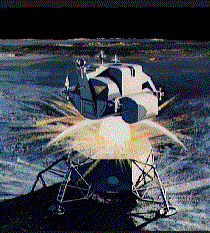 |
We will come back to
this important difference between the Earth's and the Moon's launch
requirements near the end of this article when I will tell you
how the Moon will be used to launch Man's first serious
space colonization efforts.
What about the water? It sounds like all water on the Moon should
have reached escape velocity.
Yes, that's what you might expect. However, some space scientists
(Watson, Murry and Brown way back in 1961) wondered if there might be water
frozen in the permanent shadows on the Moon. To understand these
permanent shadows requires some explanation and that starts with
an understanding about the tilt of the Moon.
The Moon's axis is titled only 1.6o from its orbital plane. By
contrast, the Earth's axis is tilted 23.5o from its orbital plane
and that tilt is responsible for the Earth's seasons. Here on
the Earth the length of each day's "daytime" (or "daylight"
if you prefer) varies considerably from place to place and from
one time of year to another. That's because of the Earth's excessive
tilt. The tilt of a planet also affects the height the Sun can
reach above the horizon. At the Earth's poles the Sun NEVER rises
more than 23.5o above the horizon because that is the angle of
tilt of the Earth from its orbital plane. To create a place of
permanent shadow at the Earth's poles you would need a deep, narrow
crater (shaped like a well).
On the other hand, at the Moon's
poles the Sun rises no more than 1.6o above the horizon because
that is the angle of tilt of the Moon from its orbital plane.
You don't need a particularly deep or narrow hole to make a permanent
shadow at the lunar poles.
| Most craters near the Moon's poles have areas of permanent shadow. The crater's rim shields the bottom from the rays of the sun. |  |
The poles of any world experience extremes of "daylight" because sunlight can barely reach them. Indeed, the surface temperature in the Moon's permanent shadows doesn't rise above -170oC (or -280oF if you use ancient temperature readings)! Here on Earth such extreme cold is never reached, even in the shadows at the poles, because the Earth's atmosphere circulates around moving heat into the shadows. The Moon has no atmosphere so it has extremes of temperature. Sunlight heats the Moon's sunlit surface to above the boiling point of water but, only a meter away in a shadow, the temperature is so low that water freezes into ice!
 | Much of the Earth's water has probably come from comets. Our solar system is full of comets and comets are full of water (ice). Comets have been smashing into the Moon and Earth for billions of years. |
The water at the bottom of a polar crater, hidden in its permanent shadow, stays put. As a matter of fact, these polar craters may actually capture water molecules as they pass by.
|
Imagine a comet hits the Moon - anywhere on the Moon. It explodes. Its water molecules get heated by the sun and they start to move around. Most of these molecules reach escape velocity and are lost from the Moon, but some slower moving water molecules wander over the Moon's surface, turning to ice when they fall into a temporary shadow and then back into steam when the shadow has moved on. These water molecules keep changing back and forth from ice to steam, ducking in and out of moving shadows, as they wander randomly over the surface of the Moon. Some of these migrating water molecules may eventually wander to a pole and become trapped in the permanent shadow of a polar crater! Then their migration stops. They are trapped in the bottom of the lunar crater "forever". | 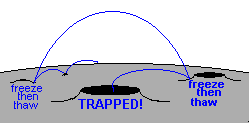 |
So, why didn't the Apollo astronauts find any water?
Because they never went to the poles. Instead, they explored the equatorial regions of the Moon because it was easier to get there, land there and go about their work with the Sun high overhead.
Why is all this so important?
We have known for decades that the Moon is rich in minerals but the apparent lack of water had been a disappointment. Water can be used to make oxygen for the colonists to breathe and rocket fuel to launch spacecraft to all parts of the solar system.
The first lunar colonists will be equipped with specially designed water-mining machines that will collect the wet, frozen lunar materials from areas of permanent shade and extract the water from it. The water will then undergo a simple electrochemical process called "electrolysis".
Electrolysis uses electricity to break up molecules. The electrolysis of water is a well-known process and it's easy to perform.
|
When an electric current is passed through water the
molecules break into ions of oxygen (O=) and hydrogen (H+).
The hydrogen cation (H+) migrates to the negative electrode (called the cathode) where there's an abundance of electrons produced by the electricity. At the cathode each hydrogen cation picks up an electron and shares it with another hydrogen cation which does the same. This creates a molecule of hydrogen gas (H2), held together by the sharing of two electrons. (That's called a covalent bond.) Oxygen anions (O=) migrate to the opposite electrode (called the anode) which has a positive charge because the electrical circuit has been set up to make that electrode deficient in electrons. At this electrode the oxygen anions give up their extra electrons and create molecules of oxygen gas (O2) held together by sharing the electrons they haven't given away. | 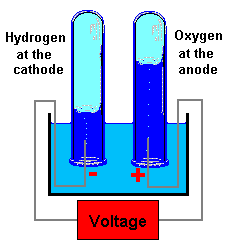
|
On the Moon the electricity will be produced by huge solar arrays situated on top of towers. The geometry that causes the bottoms of lunar polar craters to have permanent shade also causes polar peaks to have permanent sunshine! If your solar array is situated more than 1.6o above the horizon it will always have sunlight falling on it. The array will need to track the Sun as it circles around the polar horizon. The Moon has no wind and only 1/6 as much gravity so lunar solar arrays can be very big and pick up a lot of sunlight.
When you make hydrogen and oxygen gas from water you put energy into the reaction in the form of electricity. Electrolysis is a quiet, even peaceful, reaction. However, when oxygen (O2) and hydrogen (H2) recombine they release all that energy in a powerful explosion.
 | It makes great rocket fuel! Space vehicles will (carefully) fill their tanks with the oxygen and hydrogen gas produced by electrolysis of lunar water. They will then launch the spaceships from the Moon by mixing and igniting these two gases, producing water and a powerful thrust that will hurl them off the Moon and on their way to other parts of the solar system. |
Why can't we do this on Earth?
We can and we do.
Electrolysis of water can be used to make plenty of hydrogen and oxygen. When hydrogen is burned by combining with the oxygen in air the energy released can be used to power engines, including cars. Water is the only waste product. It's an environmentally friendly way to make energy but it costs a lot to do the electrolysis. Electricity doesn't come free. Even solar powered electrolysis costs too much because the solar arrays that produce the electricity are costly. However, one day this may change.
On the Moon the economics are a bit different. There are no cloudy days on the Moon and no nights if you place the solar arrays more than 1.6o above the polar horizon. More importantly, the oxygen and hydrogen gas produced on the Moon will be easily available to space travelers because the Moon is a MUCH better place to "fill up" a spaceship's fuel tanks. That's because of the Moon's better "launch requirements".
I promised at the beginning of this article that we would come back to "launch requirements". You will recall that the Earth is a lousy planet for launching space vehicles. The Earth's atmosphere causes much drag and complications like bad weather. The Earth's gravity is also an important factor. Space scientists like to say that the Earth is at the bottom of a "gravity well" of its own making. To launch a spaceship from the Earth the ship must climb out of Earth's gravity well using a great deal of energy and all that energy must be provided by the rocket's thrust. And it must fight the Earth's atmosphere as it goes through it.
The Moon, on the other hand, has a very shallow gravity well and no atmosphere so it's a lot easier to launch from the Moon than from the Earth.
People familiar with space travel like to use "delta-V" diagrams to illustrate how much speed, and therefore how much energy, is needed to get from place to place. The word "delta" is a Greek letter used to represent "change" and the "V" stands for "velocity". Here's a diagram showing some of the velocity changes need to get around. The length of each line represents the velocity change to move a spaceship from place to place. (It is NOT the distance to get there.)
|
The bigger the delta-V the more energy you need. You can use diagrams
such as these to get an idea of the best ways to move around the
Earth-Moon system.
Note: these values don't take into account the drag caused by the Earth's atmosphere.
You can see immediately that it is easier to leave the Moon than
leave the Earth. The Moon's escape velocity is only 2.38 kilometers
per second. To escape from the Earth requires a velocity almost
five times as fast (11.2 kilometers per second).
I've also drawn in the delta-Vs for some orbits. Let's take a
closer look at them.
For a real surprise, let's look at the delta-Vs to get to a low Earth orbit. It takes 2.2 kilometers per second to achieve lunar orbit and another 4.1 kilometers to move on to the low Earth orbit. That's a total delta-V of 6.3 kilometers per second. (Just add them up.) Compare that to the delta-V to achieve the same orbit from the Earth's surface - 8.6 kilometers per second. That means it takes LESS energy to go from the surface of the Moon to the Station than to get there from the Earth! |  |
Remember, the lower the delta-V the lower the energy needed. In the next century, people living in a low Earth orbit will probably drink water mined on the Moon because it is easier to transport Moon water than Earth water to an Earth orbiting space station! Indeed, most of the structure of a space station could be made on the Moon and then launched to a low Earth orbit.
It would make sense to use the Moon to supply all the fuel (produced by the electrolysis of lunar water) and perhaps even the "bulk" of an interplanetary ship itself. All you need from Earth would be the people and equipment. Eventually even they would be best when "made on the Moon"! Launching vehicles from the Moon does not harm any ecosystems, doesn't get delayed by the weather and, of course, you don't have to worry about drag.
Colonizing the Moon will launch our species on its greatest adventure. Once you climb out of the Earth's gravity well, there's not much of a reason to turn back!
Who owns the Moon's water?
In 1966 many of the United Nations, including the USA,
signed the "Treaty on Outer Space". Basically it says
that the resources in space do not belong to anyone because they
belong to everyone. According to the treaty no country can own
the Moon and therefore no country can own the water on it. This
treaty, like many of the UN's international treaties, is really
nothing more than a "gentlemen's agreement". It explains
that the Moon can be used only for peaceful purposes. Like Antarctica,
the Moon is meant to be nothing more than a research post. However,
also like Antarctica, we may be compelled by economics to harvest the resources.
It would be awful if we are not "allowed"
to utilise lunar resources to colonise space.
Indeed, as we approach the next millennium it makes sense that we evaluate our future and discuss our intentions about lunar colonization and development. If the 1966 Treaty and its negotiations are anything to go by, underdeveloped nations will argue that they have a right to as much of the lunar resources as the rich nations and will demand compensation or inclusion in any plans to mine it. If international "reality" is anything to go by, the Moon will be developed by the rich nations who will use it to move into space.
The 21st century will see mankind move to the Moon and further into the universe.
 | We will do this as a single worldwide initiative, a cohort of just the space-faring nations or maybe as a conglomerate of private industries. |
Who knows?
What about building the lunar colony? Is this really "doable"?
Yes, it is "doable"!
 For decades there have been plans on the drawing boards to build
colonies on the Moon. These plans include details of how to mine
the Moon for aluminum, iron and titanium as well as the manufacturing
methods to make glass and steel. Apollo discovered plenty of minerals
on the Moon, enough to build plenty of structures using solar
(or nuclear) power to forge them.
For decades there have been plans on the drawing boards to build
colonies on the Moon. These plans include details of how to mine
the Moon for aluminum, iron and titanium as well as the manufacturing
methods to make glass and steel. Apollo discovered plenty of minerals
on the Moon, enough to build plenty of structures using solar
(or nuclear) power to forge them.
Closed ecosystems have been developed, and continue to be developed, from which we can learn how to grow crops on the Moon and recycle the lunar colonies' atmosphere, water and other resources. Sadly, Apollo found very little nitrogen on the Moon so this element might have to be imported from Earth until a more convenient source can be found. On the other hand, maybe there's some frozen ammonia (NH3) in the permanently shaded regions. Why not? Comets have ammonia as well as water and Prospector's sensors detect hydrogen. Hmm? I wonder how much of that hydrogen is frozen ammonia!
Certainly our first step will be to send a lander (probably a robot) to at least one pole in order to get more information and test some of our ideas about how to best mine the water. Such a lunar lander might even include a sample return. From the information a lander provides we will be able to make more detailed plans about how and where to set up a lunar colony.
|
The discovery of water on the Moon could be the most important
discovery since Man learned to use the winds to sail his ocean
ships.
It could open up new worlds, new adventures and new possibilities. We have the technology and the know-how to make it work. |  |






If you have a comment or question about lunar water feel free to send a Letter to the Editor. ![]()
I can't promise to answer all your questions or address all your comments, but I'll post a few particularly good ones here.
Return to the Science Explained Homepage.